Dill and caraway are the same thing or not: we understand the issue and learn to distinguish between them
In appearance, caraway and dill have a certain similarity: their seeds and bushes are almost the same color and diameter. But if you look closely, the difference is visible. These two plants can be distinguished at the time of flowering. In the article, we will take a closer look at what it is, the similarities and differences between caraway and dill, as well as their useful properties.
The content of the article
Caraway and dill are the same or not
Outwardly, the fruits of caraway are very similar to dill, and it is easy to confuse them. In fact, these herbs belong to different families: they differ in botanical characteristics and cultivation characteristics.
Reference. The name "dill" comes from the word sprinkle. Previously, they did not cut, but sprinkle the dill, that is, they tore the leaves and sprinkle the dish immediately before serving.
It is believed that dried Dill seeds - this is cumin. Many people think so because the seeds of dill and caraway are the same color and almost the same size. However, this opinion is wrong.
What is the difference
To distinguish between these two plants, let's look at the crop data:
- they belong to different plant families, for example, dill grows during one season, and caraway is a biennial;
- in caraway, the foliage is oval and has an oblong shape, and in dill, the leaves are pinnately dissected;
- cumin blooms with white-pink flowers, and dill has yellow inflorescences;
- ripe caraway seeds are harvested in summer, and dill in autumn;
- for dill, almost all parts of plants are used, and for caraway, only fruits are used.
Caraway
Cumin is a plant that is mainly used as a condiment or added to baked goods. It is popular in European cuisine and is used in cooking recipes in other countries.
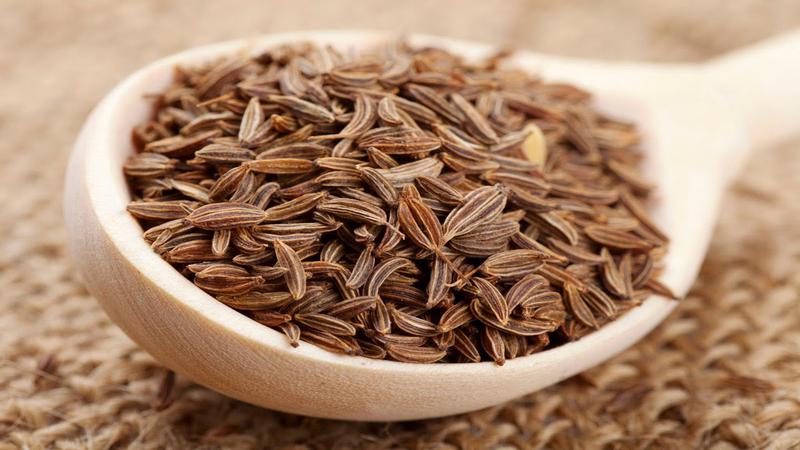 Caraway is a biennial plant, up to 90 cm high. It belongs to the family of umbrella plants. Consists of a grooved stem of a straight shape with a large number of branches. Leaves are oblong, most often quailous, have several swollen sheaths.
Caraway is a biennial plant, up to 90 cm high. It belongs to the family of umbrella plants. Consists of a grooved stem of a straight shape with a large number of branches. Leaves are oblong, most often quailous, have several swollen sheaths.
The inflorescences are small, white-pink in color, collected in small umbrellas, which include up to 16 rays. The fruit consists of semi-fruits, painted dark brown, convex in shape, each of them has five light ribs. Caraway begins to bloom in late May or early June, and the fruit ripens in July or August.
Cumin consists of chemical components:
- fatty oil;
- flavonoids;
- proteins;
- tannins;
- essential oil;
- limonene;
- carvone;
- carvacrol.
Dill

An annual plant that is used as a spice for soups, salads and other dishes, and is also used for salting and pickling preparations for the winter.
Belongs to the umbrella family, in height bush grows up to 140 cm. The stem of the plant is straight and very branched, has thin stripes and a coating similar to wax. The leaves are pinnately dissected, located on narrow subulate lobules. The lower the leaves are, the longer they are. Inflorescences are small, yellow, collected in a multi-rayed umbrella, the size of which is 30 cm. It begins to bloom in June or August.
Composition:
- essential oils;
- nitrogenous and nitrogen-free substances;
- sugar;
- cellulose;
- karatin;
- dillapiol;
- pellandrene;
- carveol;
- isoeugenol;
- vitamin C;
- vitamins B1, B2, P, PP;
- potassium;
- calcium;
- phosphorus;
- iron.
How to distinguish by appearance
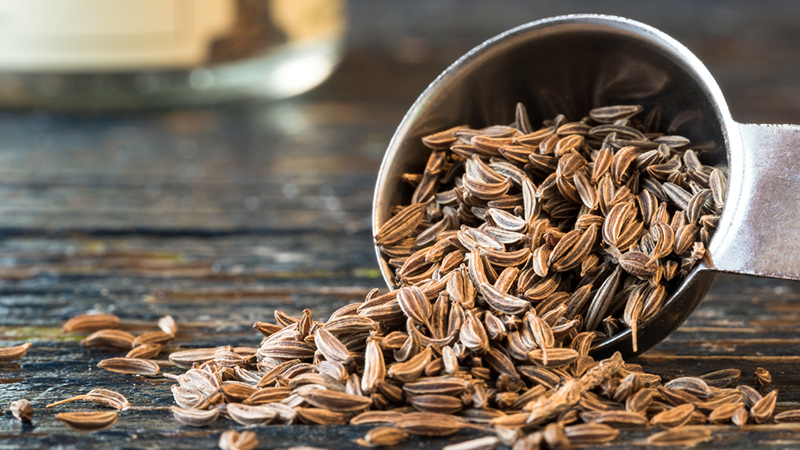
Thyme and dill can be distinguished by the following features:
- dill seeds are flat and slightly smaller in size than caraway seeds;
- in caraway seeds have a curved shape, their size most often does not exceed 3 mm in length.
Differences in taste and smell
Fresh dill greens tastes like fennel, because of this they are often confused. The leaves are especially aromatic. The seeds taste slightly bitter, leaving a sweet citrus aftertaste. The aroma of the fruit is similar to that of camphor.
Caraway has a pungent and strong smell and taste that is a bit like dill greens. Each person can feel differently: someone claims that the smell of caraway is similar to the nutty one, others compare it to grass.
The difference in beneficial and harmful properties
Let's consider the useful and harmful properties of caraway seeds and dill in more detail.
Useful properties of cumin:
- the composition contains a large amount of vitamin E;
- has an antioxidant effect;
- strengthens the human immune system;
- eliminates some types of pain;
- has a diuretic effect;
- improves milk production in lactating women;
- normalizes the digestive system;
- has a relaxing and calming effect;
- has a beneficial effect on male potency;
- accelerates the metabolism in the body;
- eliminates unpleasant odor from the oral cavity;
- improves blood circulation.
Useful properties of dill:
- improves digestion;
- normalizes metabolism;
- tones up blood vessels;
- prevents atherosclerosis;
- normalizes choleretic and diuretic functions of the body;
- promotes the treatment of cystitis and inflammatory kidney diseases;
- improves sleep;
- accelerates the elimination of toxins and toxins from the body;
- normalizes the work of the heart and blood vessels;
- has a diuretic effect.
In case of individual intolerance, cumin can cause an allergic reaction.
Dill harm: dilates blood vessels, with frequent use this leads to deterioration of vision. It is better for pregnant girls to stop using or eat it in small quantities. People suffering from atony of smooth muscles of the gastrointestinal tract, it is not recommended to eat it in any form.
Application
Dill and cumin are used not only for food. These plants are popular in medicine, cosmetology, cooking, cheese making, as well as in other industries.
Interesting! In India, cumin is an essential ingredient in soap making.
Caraway
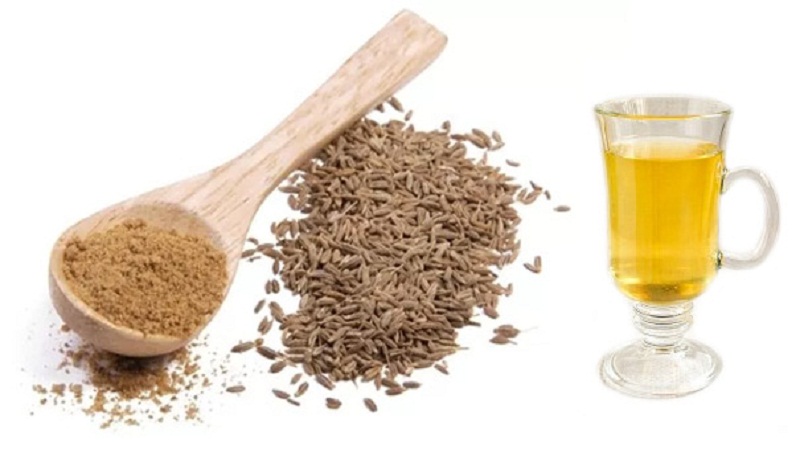
The use of cumin in cooking:
- added to bread and baked goods;
- used for homemade preparations and pickles;
- added to some alcoholic beverages;
- seasoning meat, soups, dressings and sauces;
- the seeds are used to make pate and cheese.
In medicine, cumin is used to treat:
- migraine;
- various lung diseases;
- intestinal colic;
- flatulence;
- constipation;
- painful digestion;
- cholecystitis;
- pancreatitis;
- inflammation of the gastric mucosa;
- pain in the gastrointestinal tract;
- diseases of the urinary tract;
- hepatitis A;
- cardiovascular disease;
- bronchitis.
People who want to lose weight include cumin in their diet. It promotes the elimination of excess fluid, reduces appetite and helps to relieve some digestive problems.
Important! During excavations, archaeologists found caraway seeds in the tombs of the pharaohs, which suggests that the plant was popular in antiquity.
Dill

Application in medicine:
- prepare an infusion, the basis of which is the stalk of dill, it is used for hypertension and kidney problems;
- the essential oil that is part of dill is used as an antispasmodic and sedative;
- dill tincture is taken to drain sputum and mucus, and also drink for hemorrhoids and allergic itching;
- dill seeds are taken to relieve muscle spasms, with chronic coronary insufficiency, with neuroses, as well as to prevent angina attacks.
In the food industry:
- dill is used for pickling vegetables;
- foliage is added as a spice to dishes;
- greens and seeds are added to baked goods, marinades, sauces, salads, soups, tea and sauerkraut, phytoncides that are part of dill help prevent premature spoilage of pickles;
- dill essential oil is added to canned food, soap and some alcoholic beverages.
In cosmetology:
- greens and dill seeds are used in the preparation of cosmetics and toilet water.
- dill is found in creams, toothpastes and deodorants;
- to eliminate edema and redness of the eyes, make lotions from the infusion of dill.
Growing features
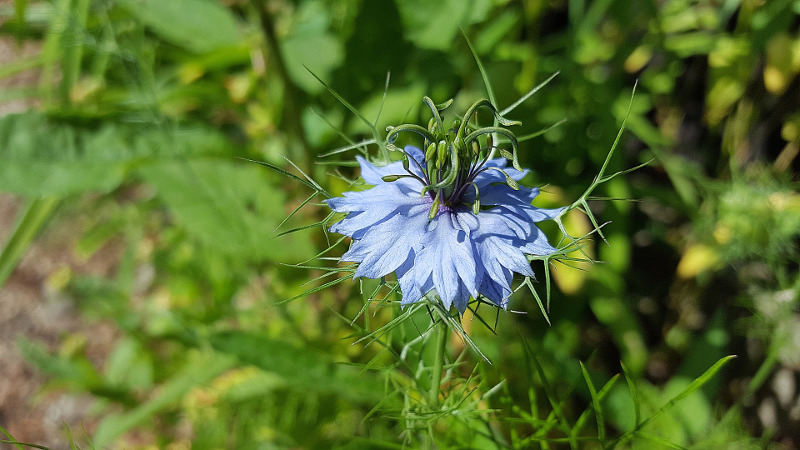
Features of growing cumin:
- they dig up the land for planting, loosen it;
- with the onset of autumn, the land is fed with nitrogen-containing and mineral fertilizers;
- caraway is planted after the snow melts and the ground warms up a little;
- seeds are planted at a distance of 35 cm from each other.
A distinctive feature of cumin is that after planting, the plant develops extremely slowly. To speed up the process, the soil is periodically loosened, weeded, watered and fertilized.
Features of growing dill:
- plant a plant near vegetables;
- planted in open areas with sufficient lighting and loose soil;
- to accelerate germination, seeds are soaked in warm water for several days, then dried and placed in the ground;
- you can plant greens in spring, summer and even late autumn, observing a distance of 5-10 cm between seedlings;
- after the first shoots of dill appear, the beds are weeded and loosened;
- fertilize the soil with manure, urea or potash salt;
- the greens are watered regularly, but not abundantly; the soil must not completely dry out.
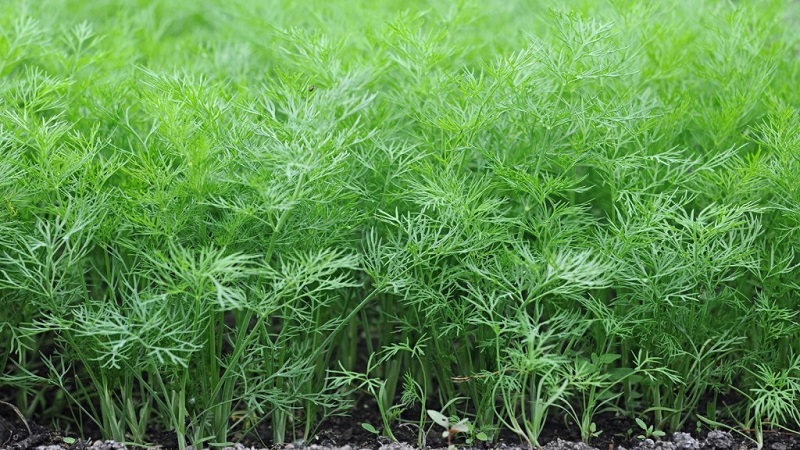
You can collect greens for salads already at the end of May. For spices, umbrellas and stems are harvested in July-August, and seeds in September-October.
Important! Dill is an unpretentious plant that can grow on any soil. The main thing is to fertilize with nutrients in a timely manner.
Contraindications
Caraway and dill are useful herbs, but they still have certain contraindications. Let's consider them in more detail.
Cumin is contraindicated:
- with increased acidity of the stomach, gastritis, stomach ulcer, gallstone disease, because essential oils irritate the mucous membrane;
- with individual intolerance to the components that make up caraway seeds, as well as people with allergies;
- with various heart diseases;
- after organ transplant, as rejection may occur.
Dill contraindications:
- hypotension;
- allergic reactions to individual components;
- pregnancy;
- diabetes;
- atony;
- low pressure;
- kidney disease.
Output
Caraway and dill look really similar in appearance, but they have significant differences. The aroma and taste make both plants indispensable in cooking. Greens are used by housewives for winter harvesting. Traditional medicine actively uses the beneficial properties of dill and cumin in its recipes.